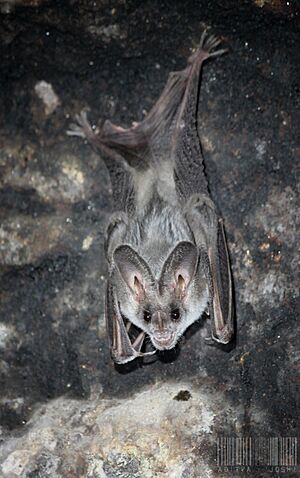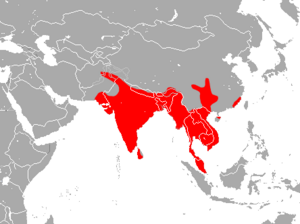Greater false vampire bat facts for kids
Quick facts for kids Greater false vampire bat |
|
|---|---|
 |
|
| Conservation status | |
| Scientific classification | |
| Genus: |
Lyroderma
|
| Species: |
lyra
|
 |
|
| Greater false vampire bat range | |
The greater false vampire bat (scientific name: Lyroderma lyra) is a cool type of bat. It belongs to a group called the false vampire bats. You can find these bats living naturally in Asia. People also call it the Indian false vampire bat or just the greater false-vampire.
Contents
What Does It Look Like?
This bat is about 6.5 to 9.5 centimeters (about 2.5 to 3.7 inches) long. It weighs between 40 and 60 grams, which is like a small candy bar. Its forearm, from the elbow to the wrist, is about 6.5 to 7.2 centimeters long.
The greater false vampire bat has big ears. It also does not have a tail. Its fur is mostly blue-gray, and it's a brownish-gray color underneath. It has a special upright nose-leaf that is about 10 millimeters (about 0.4 inches) long.
Where Do They Live?
These bats live in many places across South Asia and Southeast Asia. You can find them in countries like Afghanistan, Bangladesh, Burma, Cambodia, and China. They also live in India, Laos, Malaysia, Nepal, Pakistan, Sri Lanka, Thailand, and Vietnam.
How Do They Live?
The greater false vampire bat is a very good hunter. It eats mostly meat. Its diet includes other bats, small birds, and even tiny reptiles. It also enjoys eating fish and large insects.
Hunting Skills
This bat is known as a "gleaning bat." This means it catches its food from the ground or from the surface of water. It can hunt in many different places. Adult bats hunt from when the sun goes down until the sun comes up. They can travel up to 4 kilometers (about 2.5 miles) to find food.
L. lyra uses different ways to catch its prey. About 85% of the time, it catches food during short flights. It flies about half a meter (about 1.6 feet) above the ground. It also uses a "sit-and-wait" method. It perches about two meters (about 6.5 feet) above the ground and waits for prey to come by.
Echolocation and Other Senses
These bats use echolocation to find things in the dark. This is like using sound waves to create a picture of their surroundings. They can also hunt by seeing their prey. Sometimes, they just listen for their prey. Scientists have even seen them catch food in total darkness without using echolocation!
Reproduction and Life Cycle
After mating, female bats separate themselves from the males. The mother bat carries her babies for about 150 to 160 days. She usually has one or two pups (baby bats).
When the pups are very small, the mother carries them with her while she hunts. But as the pups get bigger, she leaves them safely in their roost (their home). The young bats drink their mother's milk for about 2 to 3 months.


